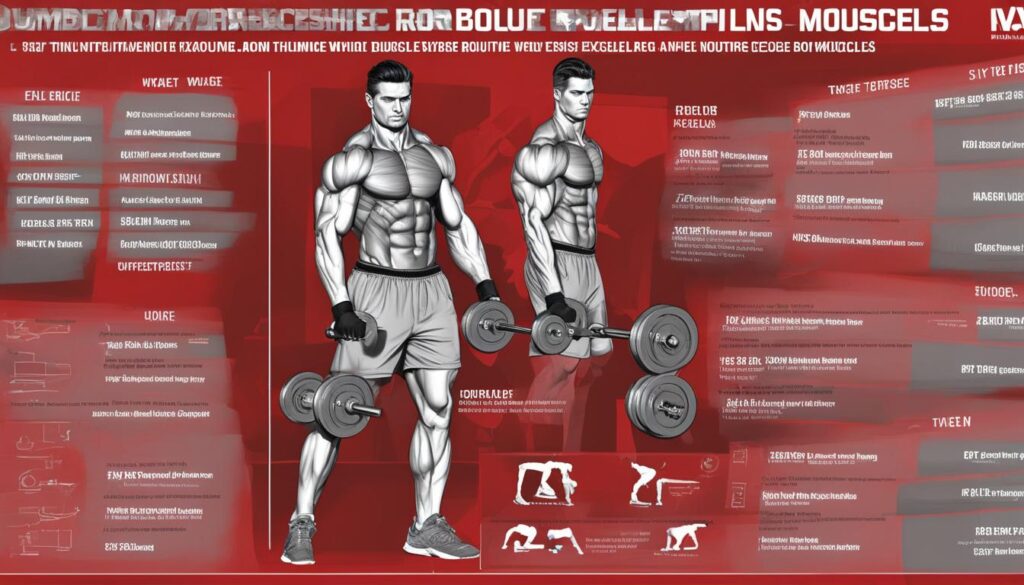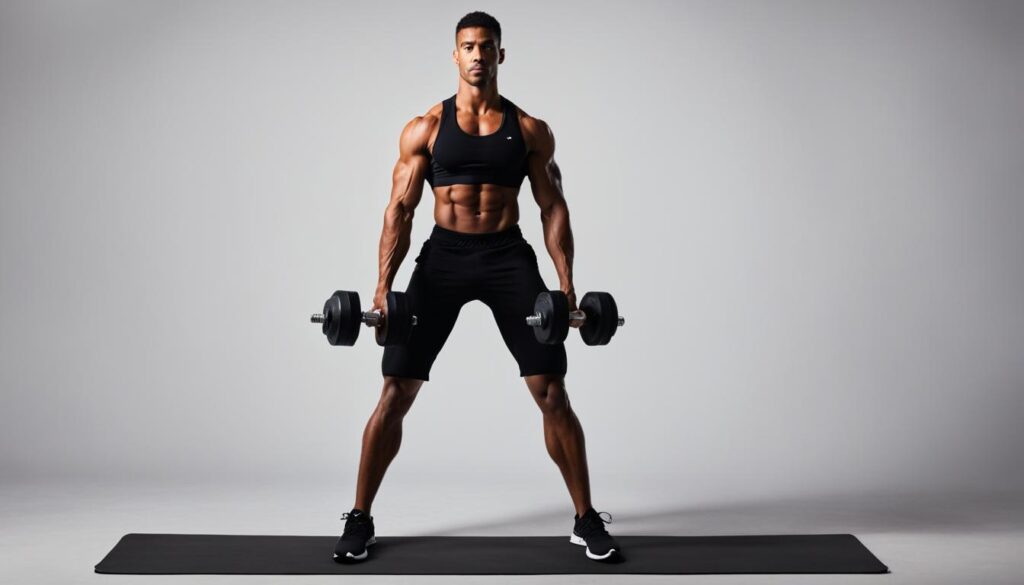The Good Morning exercise with dumbbells is a powerful way to engage multiple muscle groups and kickstart your workout routine. This versatile movement targets the hamstrings, glutes, spinal erectors, and transverse abdominals, making it an effective warm-up exercise or a preparation for heavier lifts.
By mimicking the motion of getting out of bed in the morning, the Good Morning exercise helps wake up your body and activate the muscles you’ll be using throughout the day. It’s a perfect way to get your blood flowing and prepare for a day of exercise and movement.
Table of Contents
ToggleKey Takeaways:
- The Good Morning exercise with dumbbells targets multiple muscle groups, including the hamstrings, glutes, spinal erectors, and transverse abdominals.
- It can be used as a warm-up exercise or as a way to prepare for heavier lifts.
- The proper form includes engaging the glutes, hinging at the hips, and maintaining a flat back throughout the movement.
- Aim for 12 to 15 reps with a 5 to 10 pound weight to optimize muscle engagement.
- Consult with a fitness professional or healthcare provider before starting any new exercise program.
How to Do a Good Morning
To perform the Good Morning exercise, start by standing with your feet shoulder-width apart and hold a pair of dumbbells in each hand. Rack the dumbbells at the base of your neck, resting on your shoulder blades. Engage your glutes, hinge at your hips, and keep a flat back as you lower your chest parallel to the ground. Drive your feet into the floor and push your hips forward to return to the starting position.
The Good Morning exercise is a compound movement that targets multiple muscle groups, including your hamstrings, glutes, spinal erectors, and transverse abdominals. By mimicking the movement of getting out of bed in the morning, this exercise serves as an effective warm-up to wake up your body and prepare for a day of exercise.
Proper form is crucial when performing the Good Morning exercise to prevent injuries. Remember to maintain a flat back throughout the movement, avoiding any rounding or overarching of your back. Focus on engaging your glutes and driving your hips back, keeping them in line with your spine. It’s also important to start with a weight that is appropriate for your fitness level and gradually increase the intensity as you build strength and confidence.
Now that you know how to do a Good Morning, let’s explore the targeted muscles and recommended reps and sets in the next section.
Expert Tip:
“As you lower your chest parallel to the ground, imagine pushing your hips back against an imaginary wall behind you. This will help you maintain proper form and engage your glutes and hamstrings effectively.”
Targeted Muscles and Reps/Sets
The Good Morning exercise is an excellent way to target and strengthen your posterior chain, specifically your hamstrings and lower back. By incorporating this exercise into your workout routine, you can build endurance and improve your overall strength in these key muscle groups.
In addition to targeting your hamstrings and lower back, the Good Morning exercise also engages other muscles in your posterior chain, including your glutes, spinal erectors, and transverse abdominals. This comprehensive workout helps to improve your overall stability and balance.
To get the most out of your Good Morning exercise, it’s important to perform the appropriate number of reps and sets. Aim for 12 to 15 reps per set, using a weight of 5 to 10 pounds. Adjust the weight according to your fitness level and gradually increase it as you build strength and confidence. By incorporating the right number of reps and sets, you can effectively challenge your muscles and see progress over time.
Here’s a simple table outlining the targeted muscles and recommended reps/sets for the Good Morning exercise:
| Targeted Muscles | Recommended Reps/Sets |
|---|---|
| Hamstrings | 12 to 15 reps per set |
| Lower back | 5 to 10 pounds of weight |
| Glutes | Adjust weight based on fitness level |
| Spinal erectors | Gradually increase weight over time |
| Transverse abdominals |
Remember to listen to your body and adjust the weight and intensity accordingly. It’s always best to start with lighter weights and focus on perfecting your form before progressing to heavier lifts.

Words from the expert:
“The Good Morning exercise is highly effective in targeting and strengthening the muscles of the posterior chain, particularly the hamstrings and lower back. Performing the exercise with the right form and incorporating the recommended reps and sets can lead to significant improvements in overall muscle strength and endurance.” – Dr. Jessica Sullivan, Fitness Specialist
Form Tips and Safety Precautions
When performing the Good Morning exercise, it’s essential to prioritize correct form to prevent potential injuries. Here are some form tips and safety precautions to keep in mind:
- Hip Position: As you lower your torso, focus on driving your hips back instead of down. This movement primarily engages your hamstrings and glutes, so maintaining proper hip alignment is crucial for targeting these muscles effectively.
- Spinal Alignment: Throughout the entire movement, ensure that your spine remains straight and neutral. Avoid rounding your back or overarching it, as these actions can lead to strain or injury in the lower back. Keep a strong and stable core to support your spine.
- Gaze: Maintain a forward gaze, in line with your spine, to promote proper posture and alignment. Avoid looking up or down, as this can disrupt your spinal alignment and potentially strain your neck muscles.
- Neck Issues: If you have any neck issues or are prone to neck discomfort, it’s advisable to start with a lighter weight. This precaution helps prevent excessive strain on your cervical spine and allows you to focus on perfecting your form before gradually increasing the intensity.
By following these form tips and safety precautions, you can perform the Good Morning exercise with confidence, minimize the risk of injuries, and maximize the benefits for your targeted muscle groups. Now, let’s delve into the numerous advantages this exercise offers.
Benefits of Good Mornings
Good Mornings offer a range of benefits that can greatly enhance your fitness routine. By incorporating this exercise into your workouts, you can experience the following advantages:
- Strengthening the entire posterior chain: Good Mornings target key muscles in your back, glutes, and hamstrings, helping to build strength and stability in these areas. This can improve your overall posture and help prevent injuries.
- Improving flexibility: The dynamic movement of Good Mornings promotes increased flexibility in your hamstrings and lower back. This can enhance your range of motion, leading to improved performance in other exercises and daily activities.
- Enhancing core stability: Good Mornings engage your transverse abdominals and spinal erectors, which are vital for core strength and stability. This can contribute to better balance and overall body control.
- Performance enhancement in compound movements: As a compound exercise, Good Mornings activate multiple muscle groups simultaneously. By strengthening these muscles, you can see improvements in compound movements like deadlifts and squats, allowing you to lift heavier weights and achieve greater results.
- Activating back muscles and neck stability: Good Mornings specifically target your back muscles, helping to activate and strengthen them. This can improve your overall back stability and contribute to better posture.
To fully enjoy these benefits, consider incorporating Good Mornings into your fitness routine. Whether you are a beginner or an advanced lifter, this exercise can be modified to suit your fitness level and goals. Consult with a fitness professional to ensure proper form and technique.
Now, let’s delve into some of the key variations and modifications of the Good Morning exercise in the upcoming sections.
“Good Mornings offer a range of benefits, including strengthening the entire posterior chain, improving flexibility, and enhancing core stability.”

Incorporating Good Mornings into Your Workout Routine
| Benefits | How to Incorporate |
|---|---|
|
|
Good Mornings are a versatile exercise that can be seamlessly incorporated into your workout routine. Since they engage multiple muscles, they serve as an excellent warm-up exercise to prepare your lower body or back for heavier lifts. By starting with a light weight and gradually increasing the intensity, you can build strength and confidence over time.
When incorporating Good Mornings into your workout routine, it’s important to remember that this exercise is more of a maintenance move rather than a heavy lift. While you can certainly challenge yourself with heavier weights, it’s essential to prioritize proper form and technique. This will ensure you reap the benefits of the exercise while minimizing the risk of injury.
One way to incorporate Good Mornings into your routine is to perform them as a warm-up exercise at the beginning of your workout. This will help activate your posterior chain and engage the muscles required for the upcoming workout. Start with a lightweight and aim for a moderate number of repetitions, focusing on maintaining proper form throughout.

Another way to include Good Mornings in your routine is to use them as a supplement to your leg or back day. After completing your main compound lifts, such as squats or deadlifts, incorporate Good Mornings to further strengthen your posterior chain and improve your overall stability.
Remember to listen to your body and adjust the intensity and volume of the exercise based on your fitness level and goals. As you progress, you can gradually increase the weight and add variations to challenge your muscles in new ways.
“I’ve found that incorporating Good Mornings into my workouts has been a game-changer for my overall leg and back development. It’s a versatile exercise that targets multiple muscle groups and helps me activate the right muscles before my heavy lifts. Plus, the increased stability and core engagement have improved my performance in other compound movements. Give it a try!” – Sarah, fitness enthusiast
Modifications and Variations
To get the most out of the Good Morning exercise and keep your workouts fresh and challenging, you can make several modifications and try different variations. These modifications and variations allow you to tailor the exercise to your needs and abilities, ensuring continuous progress and preventing plateaus. Here are some ideas to mix up your Good Morning routine:
1. Change the Weight
One simple way to modify the Good Morning exercise is by changing the weight you’re using. If you find that the dumbbells you’re currently using are too light, try increasing the weight to provide a greater challenge for your muscles. On the other hand, if you’re struggling with the current weight, consider using lighter dumbbells to focus on proper form and technique.
2. Resistance Band Good Mornings
If you don’t have access to dumbbells, you can still perform the Good Morning exercise using a resistance band. Simply step on the band and hold the handles at shoulder height, with your palms facing forward. Engage your core and hinge at your hips to lower your torso, keeping the tension in the band. This variation provides a similar stimulus to the traditional Good Morning exercise and helps improve your strength and stability.
3. Front-Loaded Good Mornings
To challenge your core and upper back muscles even more, you can try front-loaded Good Mornings. Hold a single dumbbell or kettlebell in front of your chest, with your elbows tucked in. This variation shifts the weight distribution and requires additional stabilization, engaging your core and upper back muscles to a greater extent.
4. Barbell Good Mornings
If you have access to a barbell, you can take your Good Morning exercise to the next level by performing it with a barbell on your back. Start with a light weight and gradually increase the load as you become more comfortable with the movement. The barbell variation allows you to handle heavier weights, targeting your hamstrings, glutes, and lower back with greater intensity.
Remember, regardless of the modifications or variations you choose, always prioritize proper form and technique. Start with lighter weights or resistance and gradually increase the intensity as your strength and proficiency improve. This approach will help you get the most out of each variation and minimize the risk of injury.
5. Complete a Table of Modifications and Variations
| Modification/Variation | Description |
|---|---|
| Change the Weight | Adjust the dumbbell or kettlebell weight to increase or decrease the challenge. |
| Resistance Band Good Mornings | Perform the exercise using a resistance band instead of dumbbells for added resistance. |
| Front-Loaded Good Mornings | Hold a dumbbell or kettlebell in front of your chest to engage your core and upper back muscles. |
| Barbell Good Mornings | Perform the exercise with a barbell on your back to handle heavier weights and increase intensity. |
Seated Good Mornings
Seated Good Mornings are a variation of the traditional standing Good Morning exercise. This advanced variation requires a higher level of flexibility and primarily targets your back muscles. To perform seated Good Mornings, you’ll need a squat rack with a barbell set at shoulder height and a bench.
Here’s how to execute seated Good Mornings:
- Position yourself under the barbell while straddling the bench.
- Maintain a slight arch in your back.
- Hinge forward at the hips, keeping the movement controlled and your back straight.
- Lower your torso until it’s parallel to the floor.
- Raise back up to the starting position by using your back and hip muscles to drive the movement.
Remember to engage your core and focus on proper form throughout the exercise. Seated Good Mornings can be challenging, so it’s essential to start with lighter weights and gradually increase the intensity as your flexibility and strength improve.
To help you visualize the correct form, here’s an image demonstrating seated Good Mornings:

Seated Good Mornings primarily target the back muscles, including the erector spinae, rhomboids, and latissimus dorsi. They also engage the glutes and hamstrings to a lesser extent. Adding seated Good Mornings to your workout routine can help improve your posture, strengthen your back, and increase overall core stability.
Benefits of Seated Good Mornings:
- Strengthening back muscles
- Improving posture
- Enhancing core stability
By incorporating seated Good Mornings into your training regimen, you can target your back more precisely and continue challenging your muscles in new ways. Remember to consult with a fitness professional before attempting new exercises or modifying your workout routine.
Other Good Morning Variations
In addition to standing and seated variations, there are other Good Morning exercise variations that you can incorporate into your fitness routine. These variations utilize different equipment, such as dumbbells or resistance bands, and target slightly different muscle groups, offering their own unique benefits.
Experimenting with these different variations can help you find the ones that work best for your fitness goals and abilities. Remember to always prioritize proper form and gradually increase the intensity as you become more comfortable and proficient with each variation.
Here are a few Good Morning exercise variations to consider:
- Single-Leg Good Mornings: This variation involves performing the exercise while balancing on one leg. It adds an extra challenge to your balance and stability while further engaging your glutes and hamstrings.
- Resistance Band Good Mornings: Using a resistance band instead of dumbbells or a barbell adds resistance throughout the entire range of motion. This variation helps strengthen the entire posterior chain and can be an excellent option for those without access to heavier weights.
- Bulgarian Split Squat Good Mornings: Combining the Good Morning exercise with the Bulgarian split squat creates a compound movement that targets both your hamstrings and quads. It’s a challenging variation that can enhance lower body strength and stability.
Remember to listen to your body and tailor your workout to your individual needs. Consulting with a fitness professional can also help you determine the most appropriate variations for your specific fitness goals and abilities.
Experiment with these and other Good Morning exercise variations to keep your fitness routine interesting and effective. Don’t be afraid to push yourself, but always prioritize proper form and safety. Enjoy the benefits of this versatile exercise and continue on your fitness journey!
Conclusion
The Good Morning exercise, when performed with dumbbells, is a versatile and effective movement that targets multiple muscle groups. It can be easily incorporated into your workout routine, whether as a warm-up exercise or as a way to prepare your body for heavier lifts.
By focusing on proper form, such as maintaining a flat back and engaging your glutes, you can maximize the benefits of this exercise. Gradually increasing the intensity by adding weight to the dumbbells will help you build strength and improve your overall flexibility.
However, it’s important to remember that before starting any new exercise program, it’s always advisable to consult with a fitness professional or healthcare provider. They can provide valuable guidance and ensure that the Good Morning exercise with dumbbells is suitable for your individual fitness level and overall health.
FAQ
What muscles does the Good Morning exercise target?
The Good Morning exercise targets your hamstrings, glutes, spinal erectors, and transverse abdominals.
How do you perform the Good Morning exercise?
To perform the Good Morning exercise, stand with your feet shoulder-width apart, hold a pair of dumbbells, rack them at the base of your neck, hinge at your hips, and lower your chest parallel to the ground. Drive your feet into the floor and push your hips forward to return to the starting position.
How many reps and sets should I do for the Good Morning exercise?
Aim for 12 to 15 reps of the Good Morning exercise with a 5 to 10 pound weight.
What form tips and safety precautions should I follow during the Good Morning exercise?
Maintain proper form by driving your hips back, keeping a straight spine, and avoiding rounding or overarching your back. Also, keep your gaze forward and start with a light weight if you have any neck issues.
What are the benefits of doing Good Mornings?
Good Mornings strengthen your entire posterior chain, improve flexibility, and enhance core stability. They also activate your back muscles and neck for stability.
How can I incorporate Good Mornings into my workout routine?
Good Mornings can be used as a warm-up exercise at the beginning of your workout routine or as a way to prepare for heavier lifts. Start with a light weight and gradually increase the intensity.
Can I modify or vary the Good Morning exercise?
Yes, you can modify the Good Morning exercise by changing the weight or using a resistance band. There are also different variations, such as front-loaded Good Mornings or using a barbell, to make the exercise more challenging.
What are seated Good Mornings?
Seated Good Mornings are a variation of the exercise where you set up a barbell in a squat rack at shoulder height, position yourself under it while straddling a bench, and hinge forward at the hips while maintaining a slight arch in your back.
Are there other variations of the Good Morning exercise?
Yes, there are other variations of the Good Morning exercise, including using different equipment such as dumbbells or resistance bands. Each variation targets slightly different muscle groups and offers unique benefits.
How should I conclude my Good Morning exercise routine?
Remember to consult with a fitness professional or healthcare provider before starting any new exercise program.











